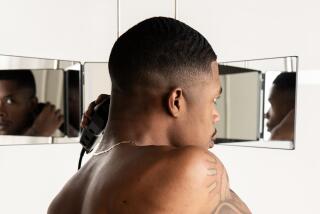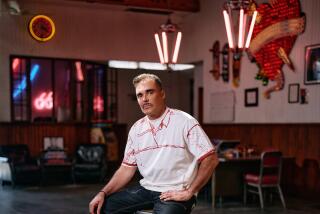Guardian of Glamour : Photographer Matthew Rolston Focuses on Images of the Past to Capture Today’s Stars
- Share via
There’s sultry, defiant Madonna, posing like Marlene Dietrich captured by Hurrell in the ‘30s, cigarette in hand, her reflection caught in a backstage makeup mirror. “I changed my mind. Good luck” is scrawled, in lipstick, on the mirror. The shot is a relatively subtle rendering of the Queen of Raunch, but undeniably powerful in its understatement.
There’s Michael Jackson, his pop highness, wearing a Sleeping Beauty-style crown, tilted to let you know he might not take this deal seriously. Nonetheless, the King of Sales is royally puffed up in velvet, leather and enough jewelry to make Mr. T jealous. Jackson’s throne, framed by stately Greek columns, is lined in ermine, begging the question: Is it camp or is it art?
And there’s Cyndi Lauper with what appears to be a chandelier on her head. She’s nude save for the ropes of pearls and chains on her chest. Lauper’s silent-screen star outfit may be the wildest get-up ever worn by the woman who introduced pink hair to the masses. Yet she looks elegant and almost serene.
The creator of these images is 35-year-old Matthew Rolston, a cherubic Los Angeles native whom many consider to be the late 20th Century’s keeper of Hollywood glamour. In his photographs, which have been collected in the just-published coffee-table book “Big Pictures” and go on display Friday at the Fahey/Klein Gallery, Rolston serves up postmodern style that seems to be caught in another era.
“Keying pictures to images in the past gives them a lot of power today. It’s like getting into symbols that people resonate with,” Rolston explains, sitting at his dining room table, dressed in his current trademark outfit: jeans and a simple gray cashmere sweater.
“The idea of postmodernism was to borrow ideas from the past, ransack the past. I hate to use the word postmodernism , it’s such a cliche, but that’s what I do.”
For the last 15 years, Rolston has been juxtaposing images of yesterday and today. Says gallery owner David Fahey, who helped Rolston edit his book and sells his work at $800 to $7,500 a photo, “He’s kind of like the court painter. He does photograph his time and place. And his time and place is Hollywood in the ‘80s and the ‘90s. But he’s not afraid of the obvious references to the early, great Hollywood photographers.”
Robert Sobieszek, curator of photography for the Los Angeles County Museum of Art, ranks Rolston among the “four mega-greats of the ‘50s and ‘60s: Avedon, Hiro, Penn and Skrebneski.
“I think Rolston is one of the foremost editorial, glamour/fashion photographers working today,” he says, “giving us immensely sophisticated, exciting, glamorous shots and portraits that surround us daily.”
Rolston’s work first received national exposure when, as a student at Pasadena’s Art Center College of Design, he was assigned to photograph Steven Spielberg for Interview magazine.
He still works frequently for the magazine (his shot of Jodie Foster is on the October cover). Says Interview editor Ingrid Sischy: “He always approaches portraiture as though each agreed-on assignment is an opportunity to take original and new pictures. He ain’t a hack. He creates the magic we associate with the high days of Hollywood glamour photography. He uses the irony and the wit of our time, and when appropriate, the references of our time.”
Rolston has shot hundreds of stars and fashion models for such publications as Vanity Fair, Harper’s Bazaar, Rolling Stone, Esquire and GQ. He was the first photographer used in the famed, prize-winning black-and-white ad campaign of The Gap retail chain, one of his “advertising patrons” that pay the bills so he can afford to do his less lucrative editorial work.
Which he does in grand, labor-intensive style.
Operating out of a large Melrose Avenue studio he built to function as a light box, Rolston employs five agents who line up his assignments and sell his work around the world. In addition, he has two full-time employees who run his studio, three camera assistants, a full-time post-production assistant and one person who has spent the last year working exclusively on his book and gallery shows in New Orleans and New York.
Still, Rolston invariably works six or seven days a week, often late into the night.
Recently, for instance, he spent the day shooting at his studio and the early evening being interviewed at his luxuriously minimal, Bauhaus-Japanese style apartment in West Los Angeles. Then he went out for a late meeting with representatives of Prince, with whom he’s discussing the possibility of directing a music video.
Next to the stereo in his bedroom was the new Prince CD, which he’d been listening to every spare second, visualizing TV images to match its rhythms. On his dining room table were piles of rare, old books of Hollywood photos, which Rolston collects and studies relentlessly. In his kitchen were more trails of a workaholic: Piles of papers, photos and books on counters where you might expect to find a food processor or canisters.
Rolston is known for doing a lot of his sleeping on the red-eyes between New York or Paris and L.A., then going right to work the second he steps off the plane. Indeed, about two years ago, when he decided to study film so he could produce moving images as well as stills, he frequently found himself flying home to go to class, then getting back on the plane. He’s now shot several television commercials for such companies as Revlon and Estee Lauder and he’s created music videos for such artists as Jody Watley and Ingrid Chavez, one of Prince’s latest proteges.
Even so, much of his time is consumed by still photography--most of it shot in the studio, with sets built for the occasion. And often, stars who he was was once assigned to shoot will now request that Rolston do the honors.
Actress and former model Cybill Shepherd, for instance, has been shot by most of the famous fashion photographers in the world, yet her favorite in Rolston.
“I think he’s surely done more beautiful pictures of me than any other photographer,” says Shepherd, who appears in “Big Pictures” in a lush, 1940s-style bathing suit shot reminiscent of Hurrell. “I think he brings out more of the inner beauty with me. I can feel freer with him. I feel that each time he sees me he’s finding something a little different.”
Many people who have observed Rolston at work comment as much on his attitude as his artistry. He is known as the consummate gentleman, a man whose shoots run extraordinarily smoothly because of the comfort and ease he imparts to everyone present, from the subject to his assorted assistants.
“Matthew nourishes the soul,” says Faye Dunaway. “Photographers can be real voyeurs. I’ve had people like that, master manipulators. You feel like their click is taking your soul. They use you and can get you into something that may not be you. Matthew gives you confidence. He makes you feel warm and secure and it’s genuine. You can feel it.”
But don’t expect Rolston to rest on such laurels and concentrate on what he does best. Already, he’s plotting a new direction, which he expects to be the subject of his next gallery show and book. He’s aware that glamour was in vogue during the ‘80s, but the ‘90s may be a different story.
“It doesn’t worry me,” he says, puffing on a Marlboro. “I’ll either use glamour in a more ironic way or I’ll do something very different, trying to create a different attitude about a social problem, either energy or children.” Rolston has been researching prominent scientists who are attempting to harness renewable energy.
“The big problems of the world are connected to the oil-based economy of the world,” he reasons. “The world runs on oil power and most of the oil is underneath countries that are not our country. So we have to get into all kinds of political maneuvering to control that.”
But, of course, as Rolston sets out to take on the vanguard scientists of the ‘90s, you can expect to see an homage to portraiture of the past. He’s already studied the more interesting photographs of Albert Einstein and is conjuring up ways to make environmental pioneers look as intriguing as Hollywood starlets.
“When you look at the modernist photography of the ‘30s and ‘40s, science was something that was very much mixed into the art world. I’d like to do that,” Rolston says. Even electric cars and solar energy plants, he notes, can be photographed with “visual glamour and excitement.”
“I’m fascinated by the subject matter, but on a purely visual level, the pictures have to work,” he adds. “One of the things I hope to do with my pictures is draw people into the romance of something, creating an aura around it by the way I photograph it.”
More to Read
The biggest entertainment stories
Get our big stories about Hollywood, film, television, music, arts, culture and more right in your inbox as soon as they publish.
You may occasionally receive promotional content from the Los Angeles Times.










